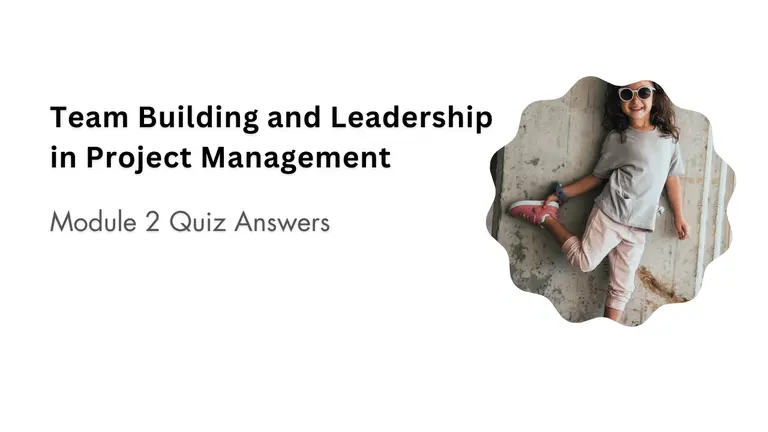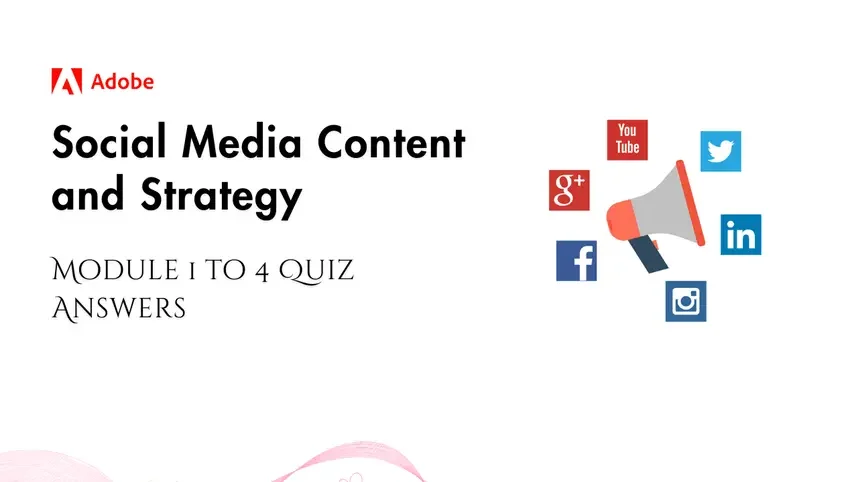Module quiz: Team Dynamics and Development Answer Key
In this article, I’m providing complete and accurate answers to the Module 2 quiz of Microsoft’s “Team Building and Leadership in Project Management” course. The answers cover the “Team Dynamics and Development” quiz, ensuring 100% correctness and covering all aspects of the course material. / Module quiz: Team Dynamics and Development Answer Key
Module quiz: Team Dynamics and Development Answer Key
Question 1)
A project leader at a production facility is overseeing a production line where two team members frequently clash over their approaches to quality control. How can the manager address this conflict?
- Transfer one of the team members to a different department to eradicate the conflict.
- Allocate them to different sections of the production line to minimize interaction.
- Arrange a meeting with the team members to openly address their concerns and find common ground.
- Leave it to the team members to sort out the disagreement among themselves.
Question 2)
Which of the following factors does not contribute to cultural conflicts?
- Food
- Work history
- Sexual orientation
- Socio-economic background
Question 3)
A project leader who is working on a large-scale project notices a lack of collaboration and knowledge exchange among team members. What action could enhance team dynamics and knowledge sharing?
- Delegate complex tasks to junior members that push their skill levels.
- Organize workshops where senior members share their experiences and expertise.
- Establish a mentoring initiative with defined objectives and scheduled meetings.
- Facilitate open team discussions to identify individual challenges and issues.
Question 4)
Building and managing virtual teams offers many advantages to fill the talent gap, but presents some unique challenges, trust building is one of them. Which of the following strategies might hinder the development of trust among virtual teams?
- Conducting frequent check-ins to monitor their activities and progress.
- Incorporating team-building activities into virtual meetings to enhance personal connections.
- Proactively resolving conflicts
- Encourage team members to take ownership of decision-making processes
Question 5)
A project leader oversees the construction of a community center, where he faces confusion about who needs to be consulted before making changes to the building design. What can the project leader develop to avoid this confusion?
- Context diagrams
- Responsibility assignment matrix
- Stakeholder register
- Influence-interest matrix
Question 6)
Which of the following is not a characteristic of high-performing teams?
- Shared commitment to achieving common goals and objectives.
- Strong sense of trust and mutual respect among team members.
- High level of conflict avoidance.
- Clear communication and defined roles and responsibilities.
Question 7)
What does BATNA stand for in negotiation models?
- Better Alternative to Negotiated Agreements
- Beneficial Alternative to Negotiated Agreements
- Best Alternative to Negotiated Agreements
- Balanced Alternative to Negotiated Agreements
Question 8)
Which of the following is the most common cause of misunderstanding when establishing a shared understanding?
- Inadequate project management tools
- Insufficient stakeholder engagement
- Communication gap
- Lack of project documentation
Question 9)
A project leader is leading a software redesign campaign. The goal is to increase user satisfaction ratings from 3.5 to 4.5 on a scale of 5 within the next quarter. How does the project leader’s goal adhere to the SMART framework?
- The goal outlines a specific target to increase the rating and the timeframe to achieve it.
- The goal lacks specificity regarding the desired outcome
- The goal does not consider the resources required for implementation
- The goal does not address potential obstacles.
Question 10)
During a kick-off meeting for a new project, team members express confusion about the project’s goals and objectives. Some members present differing interpretations of what the project aims to achieve. What should the project leader do to address this situation?
- Facilitate a discussion to clarify project goals and objectives.
- Proceed with the project as planned and clarify goals later.
- Assign tasks to team members based on their skills and experience.
- Provide a detailed project schedule to clarify goals.
Extra Questions Added
Note: For additional resources, also check out: Microsoft Project Management Fundamentals: Coursera Quiz Answers
Question 11)
True or False: Accommodating is a form of win-win conflict resolution mode.
- True
- False
Question 12)
An IT project leader is overseeing the development of a high-end web application that demands a highly collaborative team from various regions of the world. What should the project leader do to avoid any cultural conflicts?
- Strengthen resilience to cope with cultural differences
- Develop a communication management plan
- Define roles and responsibilities using the responsibility assignment matrix
- Invest in cultural awareness training to enhance sensitivity and understanding
Question 13)
Which of the following are the primary challenges faced by the project leaders to manage virtual teams? Select two
- Communication
- Trust
- Geographical boundaries
- Technical expertise
Question 14)
In a RACI matrix, what does I represent?
- Informed
- Involved
- Instructed
- Interested
Question 15)
In the middle of a project, stakeholders provide conflicting feedback about the project goals. Some stakeholders emphasize cost reduction while others prioritize quality improvement. How should the project leader resolve this issue?
- Prioritize cost reduction since it aligns with the majority of stakeholders
- Facilitate a meeting to discuss stakeholders’ concerns and reach a consensus to project goals.
- Escalate the issue to the project sponsor.
- Ignore stakeholders’ feedback and proceed with the project as planned.
Question 16)
A project leader is leading a team in a new market where cultural norms differ significantly. She observes that her assertive communication approach is met with resistance from team members. What should she prioritize to address this issue?
- Improve cultural awareness and develop empathy towards different cultural backgrounds.
- Improve predisposition to cultural shocks.
- Review and adjust the project communication management plan.
- Review stakeholder’s register
Question 17)
True or False: In the mediation technique of collaborative conflict resolution, the conflicting parties do not have control over both the process and the outcome of the conflict.
- True
- False
Question 18)
A project leader is overseeing a design and marketing campaign involving team members from diverse geographical regions. Which techniques can she employ to overcome the communication challenges of managing virtual teams? Select two
- Establish a communication culture
- Embrace technology
- Define roles and responsibilities
- Performance tracking
Question 19)
In a customer service department, team members with diverse skills and backgrounds leverage their strengths. They collaborate on projects and actively seek feedback to improve their performance continuously. Which characteristics of a high-performing team are illustrated by the team members?
- Strong leadership
- Open communication
- Shared vision
- Diversity and inclusion
Question 20)
Which of the following best describes BATNA?
- The highest offer a negotiator is willing to accept.
- The best outcome a negotiator hopes to achieve
- The lowest offer a negotiator is willing to accept
- The best alternative course of action a negotiator can take if negotiation fails.
Question 21)
True or False: A project leader feels the team members are poorly connected, showing minimal collaborative behavior. She planned to improve collaboration among team members to achieve project deliverables on time. Is the objective, to enhance team collaboration specific within the SMART framework?
- True
- False



